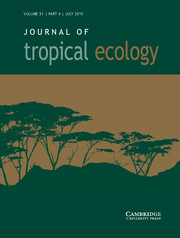Crossref Citations
This article has been cited by the following publications. This list is generated based on data provided by
Crossref.
Moss, Brian
2015.
Mammals, freshwater reference states, and the mitigation of climate change.
Freshwater Biology,
Vol. 60,
Issue. 9,
p.
1964.
Sitters, Judith
Atkinson, Carla L.
Guelzow, Nils
Kelly, Patrick
and
Sullivan, Lauren L.
2015.
Spatial stoichiometry: cross‐ecosystem material flows and their impact on recipient ecosystems and organisms.
Oikos,
Vol. 124,
Issue. 7,
p.
920.
McFadden, Tyler Neal
Kauffman, J. Boone
and
Bhomia, Rupesh K.
2016.
Effects of nesting waterbirds on nutrient levels in mangroves, Gulf of Fonseca, Honduras.
Wetlands Ecology and Management,
Vol. 24,
Issue. 2,
p.
217.
Moss, Brian
2017.
Marine reptiles, birds and mammals and nutrient transfers among the seas and the land: An appraisal of current knowledge.
Journal of Experimental Marine Biology and Ecology,
Vol. 492,
Issue. ,
p.
63.
Reef, Ruth
Atwood, Trisha B.
Samper‐Villarreal, Jimena
Adame, Maria Fernanda
Sampayo, Eugenia M.
and
Lovelock, Catherine E.
2017.
Using eDNA to determine the source of organic carbon in seagrass meadows.
Limnology and Oceanography,
Vol. 62,
Issue. 3,
p.
1254.
Rog, Stefanie M.
Clarke, Rohan H.
Cook, Carly N.
and
Cowie, Robert
2017.
More than marine: revealing the critical importance of mangrove ecosystems for terrestrial vertebrates.
Diversity and Distributions,
Vol. 23,
Issue. 2,
p.
221.
Davies, Tegan K.R.
Lovelock, Catherine E.
Pettit, Neil E.
and
Grierson, Pauline F.
2017.
Short-term microbial respiration in an arid zone mangrove soil is limited by availability of gallic acid, phosphorus and ammonium.
Soil Biology and Biochemistry,
Vol. 115,
Issue. ,
p.
73.
Lovelock, Catherine E.
Feller, Ilka C.
Reef, Ruth
Hickey, Sharyn
and
Ball, Marilyn C.
2017.
Mangrove dieback during fluctuating sea levels.
Scientific Reports,
Vol. 7,
Issue. 1,
Hickey, S.M.
Callow, N.J.
Phinn, S.
Lovelock, C.E.
and
Duarte, C.M.
2018.
Spatial complexities in aboveground carbon stocks of a semi-arid mangrove community: A remote sensing height-biomass-carbon approach.
Estuarine, Coastal and Shelf Science,
Vol. 200,
Issue. ,
p.
194.
Buelow, Christina A.
Baker, Ronald
Reside, April E.
and
Sheaves, Marcus
2018.
Nutrient subsidy indicators predict the presence of an avian mobile-link species.
Ecological Indicators,
Vol. 89,
Issue. ,
p.
507.
Hayes, Matthew A.
Jesse, Amber
Welti, Nina
Tabet, Basam
Lockington, David
Lovelock, Catherine E.
and
Wurzburger, Nina
2019.
Groundwater enhances above‐ground growth in mangroves.
Journal of Ecology,
Vol. 107,
Issue. 3,
p.
1120.
Vermeij, Geerat J.
2019.
The efficiency paradox: How wasteful competitors forge thrifty ecosystems.
Proceedings of the National Academy of Sciences,
Vol. 116,
Issue. 36,
p.
17619.
Reis, Carla R. G.
Reed, Sasha C.
Oliveira, Rafael S.
and
Nardoto, Gabriela B.
2019.
Isotopic Evidence that Nitrogen Enrichment Intensifies Nitrogen Losses to the Atmosphere from Subtropical Mangroves.
Ecosystems,
Vol. 22,
Issue. 5,
p.
1126.
Loganathachetti, Dinesh Sanka
Poosakkannu, Anbu
and
Muthuraman, Sundararaman
2020.
Encyclopedia of Marine Biotechnology.
p.
2001.
Lambrides, Ariana B.J.
McNiven, Ian J.
Aird, Samantha J.
Lowe, Kelsey A.
Moss, Patrick
Rowe, Cassandra
Harris, Clair
Maclaurin, Cailey
Slater, Sarah A.
Carroll, Kylie
Cedar, Malia H.
Petchey, Fiona
Reepmeyer, Christian
Harris, Matthew
Charlie, Johnny
McGreen, Elaine
Baru, Phillip
and
Ulm, Sean
2020.
Changing use of Lizard Island over the past 4000 years and implications for understanding Indigenous offshore island use on the Great Barrier Reef.
Queensland Archaeological Research,
Vol. 23,
Issue. ,
p.
43.
Zimmer, Martin
and
Helfer, Véronique
2021.
Dynamic Sedimentary Environments of Mangrove Coasts.
p.
369.
Aljahdali, Mohammed O.
Alhassan, Abdullahi B.
and
Zhang, Zhaohui
2021.
Environmental Factors Causing Stress in Avicennia marina Mangrove in Rabigh Lagoon Along the Red Sea: Based on a Multi-Approach Study.
Frontiers in Marine Science,
Vol. 8,
Issue. ,
Arceo-Carranza, D.
Chiappa-Carrara, X.
Chávez López, R.
and
Yáñez Arenas, C.
2021.
Mangroves: Ecology, Biodiversity and Management.
p.
63.
Alhassan, Abdullahi Bala
Aljahdali, Mohammed Othman
and
Liu, Jian
2021.
Nutrient and physicochemical properties as potential causes of stress in mangroves of the central Red Sea.
PLOS ONE,
Vol. 16,
Issue. 12,
p.
e0261620.
Bindiya, E. S.
Sreekanth, P. M.
and
Bhat, Sarita G.
2023.
Conservation and Sustainable Utilization of Bioresources.
Vol. 30,
Issue. ,
p.
323.




